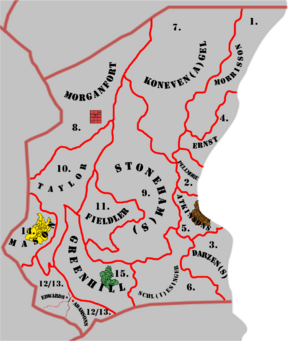Nobility of Nasphilitae (Pacifica)
| Nobility Grand Duke of Nasphilitae | |
|---|---|
 Royal Coat of Arms for the Grand Duchy of Nasphilitae | |
| Incumbent | |
| Dawson Ernst since January 2, 2024 | |
| Details | |
| Style | Royal Highness, Highness The Grand Duke of Nasphilitae is also the Head of State of Nasphilitae |
| Heir apparent | T.B.D. |
| Heir presumptive | Elected |
| First monarch | Earl John Greenhill |
| Formation | December 1, 1661 |
| Residence | Royal Chambers of House Ernst (official residence) Noble Palace of Fortress Behemoth (working residence) |
| Appointer | Elected |
Nobility of Nasphilitae ⟪nāsfɪlɪtɛ⟫ consists of fifteen Peers (referred to as "Serene Highness") landed by respective one of fifteen Peerages and seventy-five Earls (referred to as "Highness") landed by respective Earldoms within one of the Peerages. The term "Peerage" is also used for "Meeting of Peerage", which refers to the procedure for electing the Grand Duke and Head of State of Nasphilitae. The Electoral Monarchy of the Grand Duchy of Nasphilitae, officially The Elected Grand Duke among Peers and Earls of Nasphilitae, often shortened to Nobility of Nasphilitae, is the Eelectoral-republican form of government by which the elected sovereign reigns over as head of state of the Grand Duchy of Nasphilitae. The current monarch is Grand Duke Dawson Ernst, who was enthroned on January 2, 2024, one day after the elections concluded and twenty-one days after the death of the previous monarch, Grand Duke Wilferd Stoneham.
The Grand Duke, the Peers, the Earls and their immediate family undertake various official, ceremonial, diplomatic, state and representational duties. Although the nobility is given extensive authorities over the government, this power has rarely been exercised, which has been often criticised in times of overbearing governments which manage to act within the scope of law and thus avoid prosecution by the Judiciary. Powers of The Grand Duke are in practice often counter-balanced by other Peer Houses and Earls, as they must approve the formal procedure by which the monarch exercises his sovereignty to the highest extent, which is enactment of "Ordinances". Powers vested in the Peers are subject to particular clauses in both Ordinance of Unifying Colonies of 1661. and The Home Rule Act of 1662, which tie them to their respective land Peerages, as well as the network of interests which forms by each Peer holding authority over their repective fifteen Earls and consequently accountability to them.
Divison of tasks exists within the monarchy, as the Grand Duke is tasked with Head of State duties, ambassadorial tasks, Supreme Commanding of the Royal Armed Forces of Nasphilitae, Chief of Commanding the Royal Airforce of Nasphilitae. As well as arbitration and/or nominating replacement in situations where the Head of Government, Head of His Majestys Shadow Cabinet and Head of The Plenary Committee are crucially in disagreemtn and/or overwhelmed with tasks. Finally, the Grand Duke is tasked with nominating his candidate for Head Commander of the Royal Armed Forces of Nasphilitae and Chief of Commander for the Royal Maritime and Naval Forces of Nasphilitae, the Head of His Majestys Cabinet for External Affairs, and the Lead Director of the Agency for Documentation and Identification, among other Peers and Earls, which assume this position upon absolute majority (which is usually understood in Nasphilitae as 55-70%) approval from both Houses of The National Parliament MP's (317-411 and 113-145).
The contemporary arrangement of nobility traces back to December 1, 1661 with the Home Rule Act which established the colonial Dominion of Nasphilitae by uniting the former Peers (until then, Earls) colonies into a single state entity. It was a result of negotiations undertaken by Earl John Greenhill, who was for this mission the first noble to be elected by other Peers for a representative duty, with a Royal Delegation from the Austral Empire. Although detailed records of these negotiations do not exist, the Empire had recognised elevating the status of nobility from Earls to Peers despite religious diversity among them, as well as recognising right of settlement to prosecuted heathens & heretics elsewhere in the Empire and beyond on Nasphilitae. In practice, this gave Nasphilitae de facto self-governance, conditional on timely and orderly deliverence of overbearingly high royal duties and being barred from trading with realms outside those of the Austral Empire. This arrangement would be changed in 1852. during the reign of Queen Dorothy Atkinsons ("Queen" being honorary rather than actual), who rationalised-monetised the royal duties, which until then have also included agricultural and processed goods. Consequently, workshops and factories were lifted from natural tax, leading to rapid industrialisation of Nasphilitae. From May 20, 1852 to December 25, 1952, Nasphilitae was referred to as the Crownlanded Grand Duchy of Nasphilitae, suggesting the intention of the Imperial Center towards forming a Commonwealth some time in the future. Possibly as consequence of The Great War, in which the Austral Empire and Nasphilitae pursued a policy of armed neutrality, this did not happen. After the HaiMen Incident in summer of 1952. and damaged supply lines across the South Pacific Ocean, Nasphilitae received the Royal Grand of Independence on December 25, 1952. Being one of the last Dominions or Crownlands to get independence, this marked the formal end of the Austral Empire, though relations between the two countries remains exceedingly positive in contemporary times.
Cause and Order of Arrival

| Name of Peer House | Time of Arrival | Thane Population | Thane Median Income (PSD Annual) | Cause of Arrival | Number of Times Grand Dukes | Temperament Alignment | Current Head of House | Number of Direct Family Members |
|---|---|---|---|---|---|---|---|---|
| Ernst | November 4, 1589 | 2150000 | 31400 | Former Donatist followers | 2 | Melancholic-Choleric | Dawson Ernst | 14 |
| Pellmore | November 2, 1589 | 2500000 | 51500 | Former Hussitist followers | 2 | Phlegmatic-Melancholic | Isaac Pellmore | 21 |
| Morrisson | November 1, 1589 | 2105000 | 20100 | Mercantile | 1 | Sanguine | Umber Morrisson | 11 |
| Darzens | November 3, 1589 | 3250000 | 41200 | Former Elbionism followers | 1 | Melancholic | Uziel Darzens (Regency) | 19 |
| Atkinsons | November 5, 1589 | 2685450 | 36250 | Jewish | 1 | Choleric | David Atkinsons | 7 |
| Schlesinger | April 11, 1594 | 400500 | 27500 | Jewish | 0 | Melancholic-Phlegmatic | Joseph Schlesinger | 19 |
| Konevenagel | August 30, 1599 | 501050 | 19440 | Former Donatist followers | 1 | Sanguine-Phlegmatic | Milla Konevenagel | 5 |
| Morganfort | February 3, 1613 | 325000 | 73450 | Former Hussitist followers | 1 | Choleric-Melancholic | Amoneta Morganfort (Regency) | 7 |
| Stoneham | January 14, 1621 | 400500 | 20500 | Former Marcionist followers | 1 | Melancholic | Ben Stoneham | 25 |
| Taylor | October 30, 1622 | 199500 | 19750 | Exile | 2 | Sanguine-Choleric | L.P. Taylor | 3 |
| Fieldler | December 25, 1625 | 210500 | 25000 | Former Marcionist followers | 0 | Melancholic-Choleric | Amenofen Fieldler | 24 |
| Edwards | March 3, 1647 | 35000 | 17350 | Former Donatist followers | 1 | Choleric | Madison Edwards | 16 |
| Adamson | March 3, 1647 | 25000 | 20250 | Jewish | 0 | Choleric | Isaiah Adamson | 14 |
| Mason | March 4, 1650 | 110000 | 51200 | Former Sabellian followers | 1 | Melancholic-Choleric | Maximalia Mason (Regency) | 5 |
| Greenhill | June 21, 1658 | 3000000 | 65500 | Unknown | 1 | Choleric-Sanguine | Theogonia Greenhill (Regency) | 10 |
Former and Current Religious Affiliation of Peer Houses and Earls
T.B.A. Soon.
Symbols of Peer Houses
OOC Note: Etymology of each Peer House surname.
History of Elected Grand Dukes
Peerage and Earldom Territory
Relations with other Nobilities
Austral Royalty
OOC Note: ?? (AKA Community-decided)
Almann Nobility
Policy of power balancing with Karnetvorian nobility for self-survival.
T.B.D.
Karnetvorian Nobility
Policy of power balancing with Almann nobility for self-survival.
??
Montacian Nobility
T.B.D.